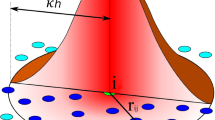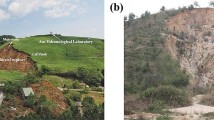Abstract
In this work, a nonlocal peridynamics–smoothed particle hydrodynamics (SPH) coupling formulation has been developed and implemented to simulate soil fragmentation induced by buried explosions. A peridynamics–SPH coupling strategy has been developed to model the soil–explosive gas interaction by assigning the soil as peridynamic particles and the explosive gas as SPH particles. Artificial viscosity and ghost particle enrichment techniques are utilized in the simulation to improve computational accuracy. A Monaghan type of artificial viscosity function is incorporated into both the peridynamics and SPH formulations in order to eliminate numerical instabilities caused by the shock wave propagation. Moreover, a virtual or ghost particle method is introduced to improve the accuracy of peridynamics approximation at the boundary. Three numerical simulations have been carried out based on the proposed peridynamics–SPH theory: (1) a 2D explosive gas expansion using SPH, (2) a 2D peridynamics–SPH coupling example, and (3) an example of soil fragmentation in a 3D soil block due to shock wave expansion. The simulation results reveal that the peridynamics–SPH coupling method can successfully simulate soil fragmentation generated by the shock wave due to buried explosion.













Similar content being viewed by others
References
Madenci E, Oterkus E (2014) Peridynamic theory and its applications. Springer, New York
Silling SA (2000) Reformulation of elasticity theory for discontinuities and long-range forces. J Mech Phys Solids 48:175–209
Bobaru F, Hu W (2012) The meaning, selection, and use of the peridynamics horizon and its relation to crack branching in brittle materials. Int J Fract 176:215–222
Gerstle W, Sau N, Silling S (2007) Peridynamics modeling of concrete structures. Nucl Eng Des 237:1250–1258
Askari A, Xu J, Silling S (2006) Peridynamics analysis of damage and failure in composites. In: 44th AIAA aerospace sciences meeting and exhibit. Reno, Nevada, AIAA-2006-88
Kilic B, Madenci E, Ambur DR (2006) Analysis of brazed single-lap joints using the peridynamics theory. In: 47th AIAA/ASME/ASCE/AHS/ASC structures, structural dynamics, and materials conference. Newport, Rhode Island, AIAA-2006-2267
Silling SA, Askari E (2004) Peridynamics modeling of impact damage. In: Moody FJ (ed) Problems involving thermal-hydraulics, liquid sloshing, and extreme loads on structures, vol 489, PVPAmerican Society of Mechanical Engineers, New York, pp 197–205
Silling SA, Epton M, Weckner O, Xu J, Askari E (2007) Peridynamics states and constitutive modeling. J Elast 88:151–184
Silling SA, Lehoucq RB (2008) Convergence of peridynamics to classical elasticity theory. J Elast 93:13–37
Tupek MR, Rimoli JJ, Radovitzky R (2013) An approach for incorporating classical continuum damage models in state-based peridynamics. Comput Methods Appl Mech Eng 263:20C26
Warren TL, Silling SA, Askari E, Weckner O, Epton MA, Xu J (2009) A non-ordinary state-based peridynamics method to model solid material deformation and fracture. Int J Solids Struct 46(5):1186–1195
Foster JT, Silling SA, Chen WW (2010) Viscoplasticity using peridynamics. Int J Numer Methods Eng 81:1242–1258
Wecknera O, Mohamed NAN (2009) Viscoelastic material models in peridynamics. Appl Math Computat 219(11):6039–6043
Tuniki BK (2012) Peridynamics constitutive model for concrete. Master thesis, Dept. of Civil Engineering, University of New Mexico, NM USA
Vermeer PA, Borst R (1984) Non-associated plasticity for soils, concrete, and rock. Heron 29(3):3–64
Matsuoka H, Nakai T (1974) Stress-deformation and strength characteristics of soil under three different principal stresses. Proc Jpn Soc Civil Eng 232:59–70
Drucker DC, Prager W (1952) Soil mechanics and plastic analysis or limit design. Quart Appl Math 10(2):157–165
Lammi CJ, Vogler TJ (2012) Mesoscale simulations of granular materials with peridynamics. Shock compressison of condensed matter-2011. Proceedings of the conference of the American Physical Society Topical Group on shock compression of condensed matter, vol 1426, pp 1467–1470
Lammi CJ, Zhou M (2013) Peridynamics simulation of inelasticity and fracture in pressure-dependent materials. The workshop on nonlocal damage and failure: peridynamics and other nonlocal models. San Antonio, TX
Alia A, Souli M (2006) High explosive simulation using multi-material formulations. Appl Therm Eng 26:1032C1042
Gingold RA, Monaghan JJ (1977) Smoothed particle hydrodynamics—theory and application to non-spherical stars. Mon Not R Astron Soc 181:375–389
Liu GR, Liu MB (2003) Smoothed particle hydrodynamics: a meshfree particle method. World Scientific, Singapore
Belytschko T, Liu WK, Moran B (2000) Nonlinear finite elements for continua and structures. Wiley, Chichester, UK
Ren B, Li SF (2013) A three-dimensional atomistic-based process zone model simulation of fragmentation in polycrystalline solids. Int J Numer Methods Eng 93:989–1014
Liu WK, Jun S, Zhang YF (1995) Reproducing kernel particle methods. Int J Numer Methods Fluids 20:1081–1106
Ren B, Li SF (2010) Meshfree simulations of plugging failures in high-speed impacts. Comput Struct 88:909–923
Liu WK, Hao S, Belytschko T, Li S, Chang CT (2000) Multi-scale methods. Int J Numer Methods Eng 47(7): 1343–1361
Chen X, Gunzburger M (2011) Continuous and discontinuous finite element methods for a peridynamics model of mechanics. Comput Methods Appl Mech Eng 200:1237C1250
Li S, Liu WK (2004) Meshfree particle methods. Springer, Berlin
von Neumman J, Richtmyer RD (1950) A method for the numerical calculation of hydrodynamic shocks. J Appl Phys 21:232–247
Monaghan JJ (1989) On the problem of penetration in particle methods. J Computat Phys 82:1–15
Ren B, Li SF (2012) Modeling and simulation of large-scale ductile fracture in plates and shells. Int J Solids Struct 49:2373–2393
Bessa MA, Foster JT, Belytschko T, Liu WK (2014) A meshfree unification: reproducing kernel peridynamics. Computat Mech 53(6):1251–1264
Li S, Liu WK (1999) Reproducing kernel hierarchical partition of unity Part I—formulation and theory. Int J Numer Methods Eng 45(3):251–288
Libersky LD, Petscheck AG, Carney TC, Hipp JR, Allahdadi FA (1993) High strain Lagrangian hydrodynamics—a three dimensinoal SPH code for dynamic material response. J Computat Phys 109:67–75
Monaghan JJ (1994) Simulating free surface flow with SPH. J Computat Phys 110(2):399–406
Campbell PM (1988) Some new algorithms for boundary values problems in smoothed particle hydrodynamics. Defence Nuclear Agency (DNA) report DNA-88-286
Torres LQ (2012) Assessment of the applicability of nonlinear Drucker–Prager model with cap to adobe. 15th world conference on earthquake engineering (WCEE), Lisboa, Portugal
Han LH, Elliott JA, Bentham AC, Mills A, Amidon GE, Hancock BC (2008) A modified Drucker–Prager cap model for die compaction simulation of pharmaceutical powders. Int J Solids Struct 45:3088–3106
Zienkiewicz OC, Chan AHC, Pastor M, Schrefler BA, Shiomi T (1999) Computational geomechanics with special reference to earthquake engineering. Wiley, Chichester, UK
Hughes TJR, Winget J (1980) Finite rotation effects in numerical integration of rate constitutive equations arising in large-deformation analysis. Int J Numer Methods Eng 15(12):1862–1867
Acknowledgments
This work was supported by an ONR MURI Grant N00014-11-1-0691. This support is gratefully acknowledged. In addition, Mr. Houfu Fan would like to thank the Chinese Scholarship Council (CSC) for a graduate fellowship.
Author information
Authors and Affiliations
Corresponding author
Rights and permissions
About this article
Cite this article
Ren, B., Fan, H., Bergel, G.L. et al. A peridynamics–SPH coupling approach to simulate soil fragmentation induced by shock waves. Comput Mech 55, 287–302 (2015). https://doi.org/10.1007/s00466-014-1101-6
Received:
Accepted:
Published:
Issue Date:
DOI: https://doi.org/10.1007/s00466-014-1101-6




